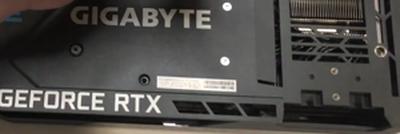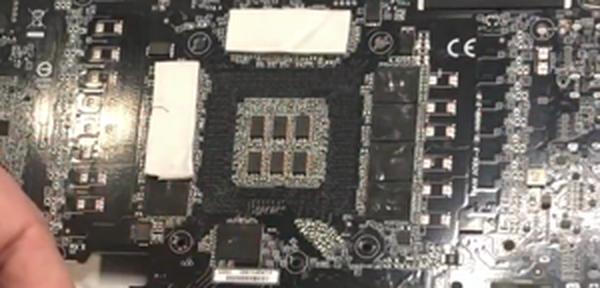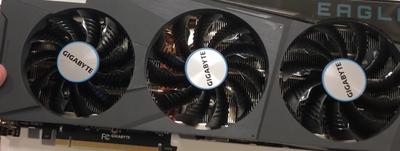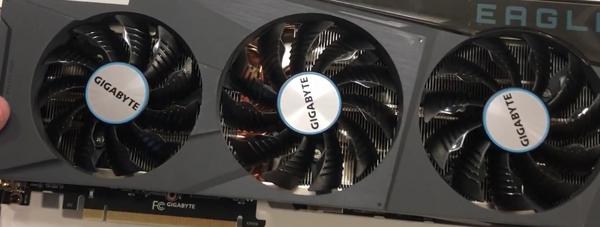
My thoughts on the Gigabyte RTX 3090 EAGLE OC 24GB Graphics Card (2024)
My thoughts on the Gigabyte RTX 3090 graphics card: architecture, performance, cooling, real-world gaming.
Introduction
I've been using the Gigabyte RTX 3090 EAGLE OC 24GB for a while now: from gaming to content creation, this card has quite a lot to offer. It's got some pros and cons, but overall, it could be a good choice if you're in the market for something powerful and afforable (compared to the latest GPUs). More on my thoughts below.
Some photos (click to enlarge)




Specs of the Gigabyte RTX 3090 EAGLE OC 24G
- Release Year
- Brand
- Graphics Coprocessor
- Graphics Ram Size
- Graphics Processor Manufacturer
- Gpu Clock Speed
Prices
Ampere Architecture Overview

The NVIDIA Ampere architecture is a powerhouse that's redefining what we can expect from high-end graphics cards. It struck me immediately how this architecture has made significant advances over its predecessor with the introduction of:
NVIDIA Ampere Streaming Multiprocessors: The building blocks for the world's fastest, most efficient GPU.
2nd Generation RT Cores: Offering more ray tracing performance.
3rd Generation Tensor Cores: Improved AI algorithms that elevate gaming to new levels.
As someone who's consistently tinkering and upgrading my rig, I've been closely watching Ampere, especially the top-tier offering that is the RTX 3090. Armed with a massive 24GB of GDDR6X memory, the RTX 3090 is a dream for both gamers and professionals. It's not just about raw power; efficiency and intelligent design play a huge role here.
One apparent strength of the RTX 3090, due to the Ampere architecture, is its ray tracing capabilities. The 2nd Generation RT Cores specifically pique my interest, as they bring substantial improvements over the first generation. This is a game-changer for rendering realistic lighting and shadows. However, I won't sugarcoat it—this card comes with a high power demand.
On the flip side, the improved 3rd Generation Tensor Cores grab my attention for their role in AI tasks, significantly DLSS (Deep Learning Super Sampling). DLSS is NVIDIA's AI rendering technology that escalates frame rates while maintaining high-quality images which, believe me, makes all the difference when you're in the heat of a game.
The RTX 3090 has also proven itself in creative workloads, handling tasks in 3D rendering and video editing like a champ, thanks to the enhanced Tensor Cores. And while GIGABYTE's WINDFORCE 3X Cooling System is a fine addition that helps maintain temperatures, it's critical to note that this card can run hot, and the sheer size may not fit in all cases. Additionally, the RGB Fusion 2.0 might be appealing for those who love a customized aesthetic, but it's not a deciding factor for pure performance seekers.
Having my hands-on experience, I agree that while GIGABYTE's model might not outpace every competitor, especially when set against brands like EVGA or Strix, it's still a formidable piece of hardware. The alternate spinning fans do lead to quieter operation, which is a plus for me as I appreciate a more silent setup.
Finally, there's the aspect of availability and pricing. The RTX 3090 cards, regardless of the brand, are challenging to find and often come with a significant price tag. This is a crucial factor to consider, especially when assessing the value-to-performance ratio.
In essence, the NVIDIA Ampere architecture is nothing short of impressive. If you manage to secure an RTX 3090, expect a stellar experience, albeit with some considerations regarding power consumption and size. It's not perfect, but the leap in performance is undeniable, and for enthusiasts like myself, it's a peek into the future of gaming and content creation.
RTX 3090 Performance Deep Dive

Navigating the raw power of the RTX 3090 has been nothing short of a technological marvel. The NVIDIA Ampere Streaming Multiprocessors at its heart mark a quantum leap from previous iterations, delivering a level of performance that I can actually feel when gaming or tackling GPU-intensive tasks.
I've boiled down my core assessments into a markdown list that encapsulates the essence of my experience:
Pros:
The 2nd Generation RT Cores translate into a smoother and more immersive experience in ray-traced games.
3rd Generation Tensor Cores propel AI tasks and features like NVIDIA DLSS, pushing framerates higher without sacrificing quality.
The sheer size of the 24GB GDDR6X memory is a game-changer for rendering and multitasking.
Cons:
Power consumption is on the higher side, making it less eco-friendly and a bit of a concern for long-term energy costs.
In comparison to some other brands like EVGA, the performance seems marginally less polished.
The WINDFORCE 3X Cooling System is a standout feature that keeps things remarkably under control, temperature-wise. Given the card's heavy lifting, a robust cooling system is an absolute must, and it delivers. I especially appreciate the quieter operation, which is a big plus in my book.
On the flip side, it's no secret that getting your hands on one of these is a hassle due to high demand and stock issues. However, once set up, I noticed a stark difference in performance. Games that used to chug along are now a visual treat. For instance, Minecraft, a seemingly simple game but with potential for resource strain, went from a measly 5-10 fps to a solid 20 fps on medium settings, once I had the 3090 up and running.
The RGB Fusion 2.0 and the protective metal backplate might seem like aesthetic choices, but for me, they underscore the premium build quality of this GPU. Meanwhile, the memory interface, clocking in at an impressive 19500 MHz, is an indicator of how the card excels in speed and bandwidth - crucial for today's high-end gaming and content creation.
With considerations of both power draw and cost, it's a sizeable investment. Still, for creators, gamers, and enthusiasts looking to push boundaries, the RTX 3090 by Gigabyte stands out as an incredible tool. Despite the odd drawback, the supremacy of its technological advances makes it a worthy contender in the high-stakes realm of top-tier GPUs.
Cooling and Aesthetics Review

When it comes to the Gigabyte RTX 3090 EAGLE OC 24GB, the WINDFORCE 3X Cooling System with alternate spinning fans is a standout feature. I've found that this cooling solution is not only effective but also intriguing in its design approach.
Key Points of the Cooling System:
Efficiency: The alternate spinning of the adjacent fans reduces air turbulence, leading to better air pressure distribution and enhanced cooling performance.
Noise level: Although these cards are powerful and thus expected to be loud, I was pleasantly surprised by the relatively quiet operation of the system.
Build Quality: The fans themselves feel robust which reassures me of the card's longevity under regular gaming and workload stress.
While on the topic of aesthetics and design, I have to mention the RGB Fusion 2.0. The customizable lighting adds a nice touch to the overall look of the card, making it a visually appealing component within my rig. Especially in a glass case setup, it truly stands out.
The metal back plate is not just for show; it adds a degree of sturdiness to the card, protecting it from bending and potential damage from handling or installation. This practical feature, coupled with the aesthetic appeal, ticks both boxes for me.
However, it's important to acknowledge that the RTX 3090 series is generally power-hungry. While the Gigabyte model might be quieter than some of its competitors, it doesn't escape the high power requirements inherent to such a high-performance card.
Another minor drawback is the size of the card. It's bulky, and while that's expected given its capabilities, it may be a tight fit in some cases. If you're considering an upgrade, make sure to measure your available space.
I'm aware that there might be slight performance variations compared to other brands like EVGA or Strix. While I find the performance of my Gigabyte RTX 3090 EAGLE OC to be impressive, in an ideal world, I might choose another brand for purely performance reasons. However, as per my personal use, the differences are not deal breakers.
As for the high-end features like 24GB GDDR6X memory and the 384-bit memory interface, they're fantastic for my creative workloads. In gaming, paired with good airflow in my case, the card stays cool under pressure, and the performance is exceptional.
All things considered, the Gigabyte RTX 3090 EAGLE OC strikes a balance between performance, cooling, and aesthetics that's hard to beat. Despite a few minor concerns, the card delivers where it counts, and it makes a solid addition to any high-end gaming or professional creative setup.
Real-World Usage Experience

Having thoroughly tested the Gigabyte RTX 3090 EAGLE OC 24GB, my experience brings a mixed bag of impressions, though largely tilting towards the positive. Here’s a summarized list of my encounters:
Pros:
The sheer graphical capabilities with the NVIDIA Ampere Streaming Multiprocessors are impressive.
2nd Generation RT Cores and 3rd Generation Tensor Cores significantly boost performance and ray tracing.
The 24GB GDDR6X memory is quite future-proof, handling high-resolution textures with ease.
The WINDFORCE 3X Cooling System maintains reasonable temperatures without unnecessary noise.
The Protection metal backplate adds a sturdy feel and a touch of class to the build.
Cons:
High power consumption is noticeable, which could be a concern for energy-conscious users.
Slightly lagging behind competitors like EVGA and ASUS Strix in terms of performance.
The GeForce RTX 3090 card, armed with a massive 24GB of GDDR6X memory, breezes through 4K gaming and creative tasks like a champ. It's a delightful change from my previous card; the frames per second count soaring from single digits to a fluid 20 in Minecraft on medium settings feels like breaking free from chains. Still, it's not lost on me that some might find even better performance with other brands.
While the AI-powered DLSS feature is nothing short of revolutionary, offering crisper images and smoother frame rates, one can't help but keep an eye on the power draw. The energy demand of this card is considerable. In an era leaning towards sustainability, it would be remiss to overlook it.
Predominantly, the new hardware features usher in a gameplay experience that's about as close to cinematic quality as one can get in a home setting. Being able to see real-time reflections and shadows breathes life into virtual worlds in ways that are deeply immersive.
Despite the unprecedented visuals, nuances in performance when compared to other top manufacturers suggest that while the Gigabyte RTX 3090 EAGLE OC is remarkable, it may not be the absolute king of the hill. For those looking to eke out every last bit of power, brands like EVGA or ASUS Strix might be worth considering.
Ultimately, it's about whittling down what matters most to you in a graphics card. For me, the trade-off of slightly lower performance for a quieter system is worth it, especially when you consider the premium experience that this RTX 3090 still provides. It offers a significant leap over the previous generation, and if you're looking to future-proof your rig, it's a strong contender. While it may not take home the gold in every category, the Gigabyte RTX 3090 EAGLE OC is a graphics powerhouse that delivers where it counts.
Comments (0)
Share